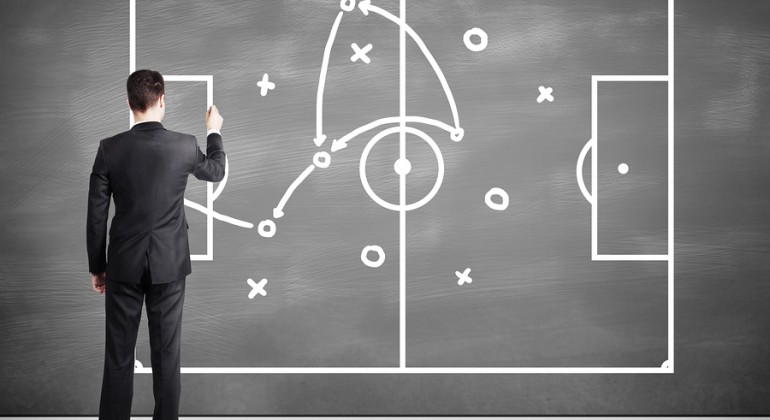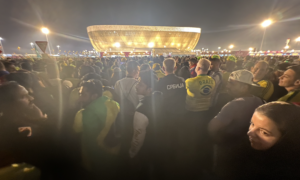Mexico’s defence has been a major issue in recent matches, particularly when dealing with counter-attacks. Tom Harrison saw some improvements during Mexico’s previous game against Russia, but there were still concerning moments. Here, Tom illustrates why delaying counters is so important, and where Mexico were successful, and unsuccessful, at doing this versus Russia.
Example 1

In the first example, when Russia receive possession, there’s some pressure on the ball. However, the pressing player hasn’t covered the open passing lane (black line), which splits Mexico’s midfield. It could be argued that here, Mexico’s most defensive midfielder, Héctor Herrera, should be sitting deeper.

The splitting pass is made, taking players out of the game and leaving a three v three situation. With Mexico holding a high-line, there’s also plenty of space in-behind the defence. Just one simple pass, after Mexico lost the ball, has created a huge problem for the El Tri defence. Too easy for Russia, and had the forward on the left not miss-timed his run and strayed offside, the problem would have been even more severe.

When the through ball is played, to the right-sided forward, Mexico’s defensive line has been pulled apart, due a mixture of closing down and recovery runs being made. Considering that Héctor Herrera has managed to get back to pressurise the player on the ball, Néstor Araújo may have been better served by backing off with Héctor Moreno, to cover him. By moving forwards, Araújo influenced the player’s decision to release the ball, which could be seen as a positive thing for Mexico. However, it didn’t help to delay the attack, at a time where Mexico could benefit from more players getting back.

The through ball was accurate, and found Alexandr Erokhin bearing down on goal on the right hand side. Fortunately, Erokhin, a midfielder, blazed his effort over the bar.
Example 2

In this example, Jonathan Dos Santos is tackled after taking a heavy touch when running with the ball.

Russia begin a counter attack, and with Mexico’s defence sat fairly deep, perhaps as they are looking to hold onto their lead, there’s plenty of space to travel into.

Russia are able to move through the midfield quickly, and with Russians committing forward, a six v six scenario is generated. This is not nearly as dangerous as the three on three from earlier in the match, but still potentially worrying for El Tri. Miguel Layún has gone to close down the ball, and his role is crucial. Keep an eye on the clock.

By remaining composed and staying on his feet, Layún delays the attack for five seconds (62:13 to 62:18), giving time for two Mexican players to make recovery runs and support the defence. Delaying a counter-attack doesn’t only allow players to make recovery runs, it also gives an opportunity for defensive shape to be regained. As highlighted, Mexico have a three v two against Russia’s two strikers, and both of the supporting attacking players are marked. Russia are forced to switch the play as they can’t currently see an opening in the Mexico defence, and are ultimately unable to create anything from this attack.
Example 3

This example shows how delaying a counter-attack can successfully take place deep in the opponents half, immediately after possession is lost. Javier Hernández has just been tackled inside the box, and the ball is running loose on the edge. Alexander Samedov (circled) moves towards the ball.

Luis Reyes senses the opportunity to press the player in possession, and by doing so prevents Alexander Samedov from turning and playing forwards. Therefore, delaying the counter-attack. It’s impossible to see with this camera angle, but presumably Samedov has no option to play forwards to Russia’s left-side. Another Mexican, on Mexico’s right-side, may have read the cue of Luis Reyes stepping up, and moved forwards himself to block off an easy out ball for Samedov. High-pressing is far more successful when adopted by the whole team, and when a compact shape is maintained. Otherwise, opponents can often easily move the ball around the pressing player.

Jonathan Dos Santos is focused, anticipates where Samedov is going to pass, and manages to move from behind the Russian into a position where he is placing pressure on the opponent. Again, there may be a significant contribution from Jonathan’s teammates here, as the player in possession can see, and pass to, a decent portion of the pitch.

The work of Jonathan, Reyes, and likely their teammates, forces Russia to play safe, and pass backwards once again. This time all the way to goalkeeper Igor Akinfeev. Akinfeev kicks long from here, and the ball is recovered by Mexico. What could have been a dangerous counter-attack failed to materialise, thanks to the immediate press of Luis Reyes, then Jonathan Dos Santos, and possibly their teammates stepping up and cutting off passing options. The combination of these moves prevented Russia from playing forwards and quickly penetrating Mexico.
Mexico are committed to playing out from the back, and are usually rather ambitious in pushing players forward. Both have many benefits, but do involve some risks. Against Germany, who should press Mexico quite high up the pitch, there’s always the risk of Mexico losing possession as they attempt to play through the thirds. Preventing Germany from making the most of transitions is likely to be be a crucial factor in determining Thursday’s victor. If Mexico can successfully delay Germany’s counters, as they did on occasion against Russia, El Tri have a chance of making it into the final.
Comments








